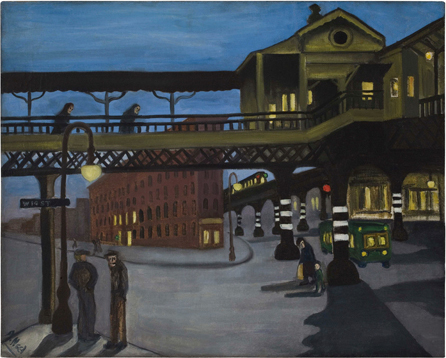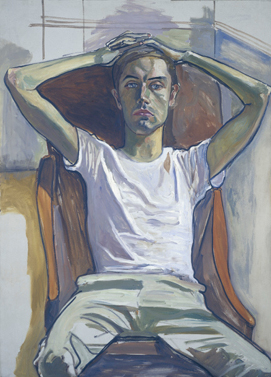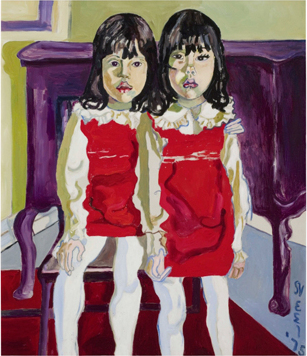
Alice Neel, Ninth Avenue El, 1935 © Estate of Alice Neel/Private collection, courtesy Cheim & Read, New York
Alice Neel Biography
In November 1921, Alice Neel enrolled for art studies at the Philadelphia School of Design for Women.
In 1923 and 1924, she won awards for portrait painting in her class. In the summer of 1924, she met Cuban artist Carlos Enríquez. In spring 1925, she graduated. On 1 June the same year, she married Enríquez, and in December the following year, she gave birth to a daughter, Santillana del Mar Enríquez. In 1927, the family moved to Bronx, New York. Santillana died in diphtheria in December. In November 1928, she gave birth to their second daughter, Isabella Lillian Enríquez (nick-named Isabetta), who was left with her father’s family in Cuba. Alice Neel only saw her again a few times. Enríquez lived for some years in Paris, and although they never formally divorced, they met for the last time in 1934.
In December 1933, Alice Neel was hired by the government programme, the Public Works of Art Project (PWAP) led by the Whitney Museum of American Art. In September 1939, she gave birth to a son, Richard. His father was the nightclub singer José Negron (who had left his wife and children for Neel). In December that year, Negron left Neel and their son. A year later, she met Sam Brody, with whom she lived periodically over the ensuing two decades. On 3 September, 1941, their son Hartley Stockton Neel was born. The family moved to Spanish Harlem in New York.
In 1944, Alice Neel showed 24 paintings in a solo exhibition at the Pinacotheca Gallery in New York. Six years later, she had another solo exhibition, this time at the A.C.C. Gallery.
In 1955, Alice Neel was interrogated by the FBI. She had been under surveillance since 1951 on account of her intermittent involvement with the Communist Party. She was described as a “romantic Bohemian type communist”. Alice Neel got involved in the women’s rights movement and participated in several marches. In 1976, she was honoured with the International Women’s Year Award, “in recognition of outstanding cultural contributions and dedication to women and art”.
In 1959, Neel appeared with Jack Kerouac, Allen Ginsberg and others in the film Pull my Daisy, the iconic art film about the beatnik era. In 1962, the article Introducing the Portraits of Alice Neel was published in Artnews. This was the first longer article about her oeuvre. The following year, Neel opened her first exhibition at the Graham Gallery in New York. The gallery represented Neel from then until 1982.
In 1974, the Whitney Museum of American Art produced the first Alice Neel retrospective, showing 58 paintings. The year after, the Georgia Museum of Art in Athens, Georgia, showed Alice Neel: The Woman and Her Work, an exhibition of 83 of her paintings.
In 1984, Alice Neel appeared on Johnny Carson’s The Tonight Show. She proved to be a great entertainer and was soon booked for other appearances. At a routine medical check-up that year, she was diagnosed with the advanced stages of cancer. In early October, Robert Mapplethorpe visited to take photographs of her. A couple of weeks later, on 13 October, 1984, Alice Neel died, in the company of her family, in her New York apartment.


